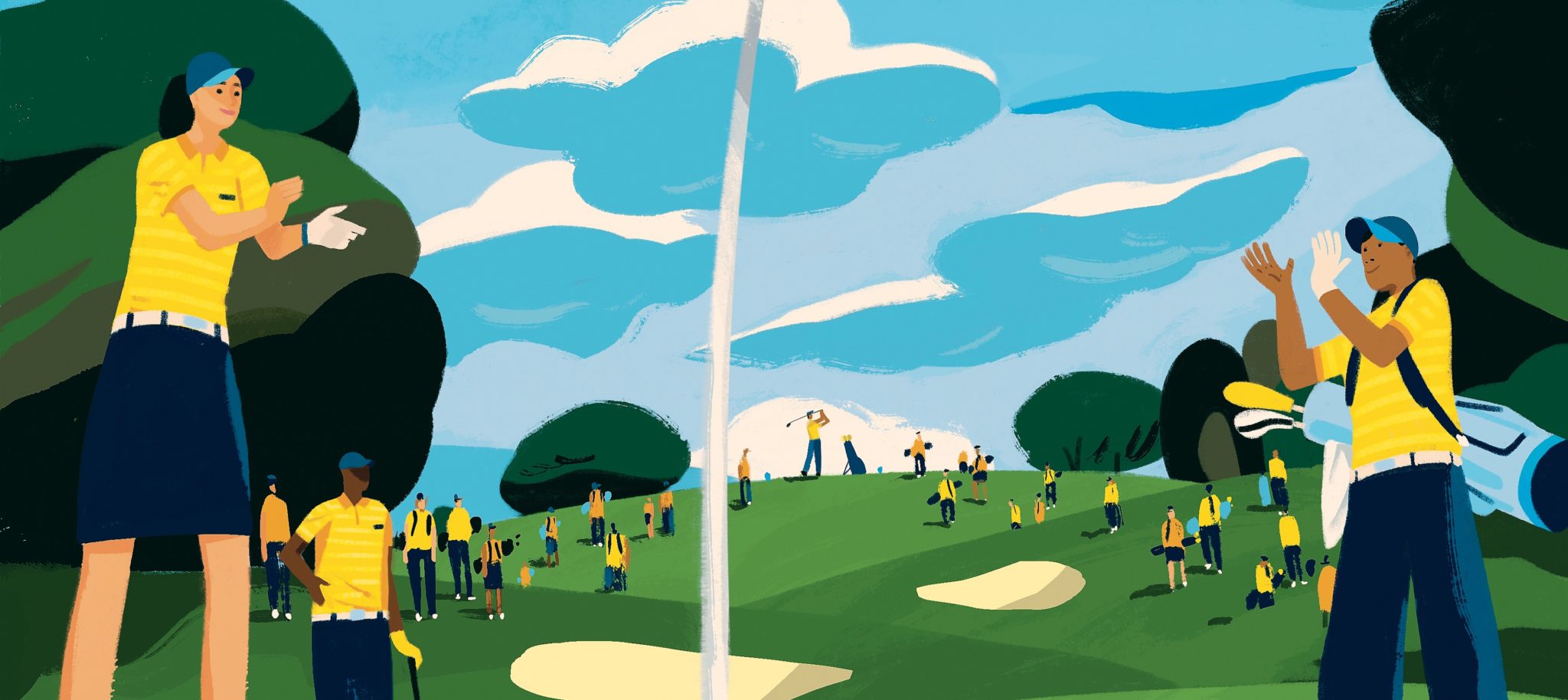When Collin Morikawa calmly sank his birdie putt on the 18th hole of the Royal St. George’s golf course in Kent, England, last July, he breathed the rarified air of someone who had reached the pinnacle of professional golf. At just 24 years of age, the 2019 Cal grad had captured the sport’s oldest tournament, the storied British Open. In the final round, he shot a 66 to hold off Jordan Spieth by two strokes.
Morikawa had made headlines 11 months earlier, when he won the PGA Championship at San Francisco’s Harding Park in August 2020. It was the first major tournament played in over a year due to the pandemic, and only Morikawa’s second major tournament. He shot 64 in the final round, tying the record for the lowest final-round score ever recorded by a PGA champion.
If that win, on a municipal course just across the bay, announced Morikawa’s arrival in golf’s upper echelon, the British Open victory, in the far-off links of Kent, proclaimed he was there to stay. The Los Angeles native became only the second player since Tiger Woods, his childhood idol, to win the Open and the PGA before the age of 25. And he did it with both remarkable grace and graciousness.
“When you put the pressure on that guy, you’re asking for trouble,” gushed NBC announcer and former PGA standout Paul Azinger after Morikawa’s performance at the British Open. “He handles it as well as anyone I’ve seen since Tiger Woods.”
Clutching the Claret Jug and beaming at the cameras in his post-match television interview, Morikawa said, “This is by far one of the best moments of my life.… Let’s hear it for [the fans].” He went on to congratulate the amateur champion, Laird Shepherd, and noted it was his caddie J.J. Jakovac’s 39th birthday. “We are so honored to be out here… It just gives me the chills.”
The comparison with Woods is interesting for another reason: Woods played two seasons at archrival Stanford, under very different circumstances than those Morikawa experienced at Cal. The well-heeled Cardinal golf program, after all, has its very own facility, the Stanford Golf Course, while Cal ventures all over the Bay Area to schedule tee times from a dozen local courses scattered from Orinda to Fairfax, not to mention a short-game practice facility next to the jetways of Oakland International Airport.

It could be worse. The team might not exist. Indeed, for a couple years in the late ’70s, Cal had no men’s varsity golf program at all. Since then, it has become a college powerhouse and produced one of the world’s best players.
And Morikawa isn’t the only former Bear on the leaderboard, either. Max Homa ’13 has also been making a name for himself on the PGA Tour. In September, the 30-year-old won the Fortinet Championship at the Silverado Resort in Napa, and, in February, the Genesis Invitational in Pacific Palisades, not far from his hometown in Burbank.
At Cal, Homa won the 2013 NCAA individual national championship and was part of the top-ranked team in the nation.
“To my mind, that’s a pretty remarkable story—how the program went from a threadbare club team to one of the powerhouse programs in the country,” says Golf magazine senior writer and Berkeley journalism alum Josh Sens. “How did Cal men’s golf manage to turn it around? How do you start drawing top talent in the backyard of schools like Stanford when you don’t even have a home course or a tricked-out training facility?”
If any single person is responsible for the success of Cal Golf, it’s former coach Steve Desimone, whose career stretched across 37 years, until 2016, when he had to step aside due to struggles with multiple myeloma, a cancer of the plasma cells.
Desimone was hired in 1979 by the former director of Cal’s Recreational Sports Facility, Bill Manning, to reenergize the golf program and get it reinstated as an NCAA varsity sport after it had been dropped (along with wrestling and men’s volleyball) by then–Athletic Director Dave Maggard.
Maggard, a former Olympic shot putter, didn’t appreciate what golf could bring to the school, says Desimone. He also felt it diverted donor money from marquee programs like basketball and football. Ironically, it was a former Cal football star who was instrumental in helping Desimone, himself a former Cal basketball player, get the program back on the varsity roster.
Frank Brunk had been a three-year letterman for the Bears from 1947–49, once returning a kickoff 102 yards for a touchdown against USC, propelling Cal into the 1950 Rose Bowl. Together with Desimone, he formed the Cal Golf Committee to raise the funds to bring the team back. According to Desimone, Maggard asked Brunk why he was supporting men’s golf and not football.
Brunk replied, “Well, Dave, I no longer play football, I play golf.”
Later, recalls Desimone, the matter nearly came to blows in a Faculty Club meeting room. Fortunately for the Cal Golf Committee, cooler heads prevailed and they gained an ally in Vice Chancellor Bob Kerley, Maggard’s boss.
By the fall of 1982, Desimone and Brunk had succeeded in their fundraising efforts and men’s golf was reinstated as a varsity sport. It came with a stipulation, however: Desimone had to promise Kerley he’d stay on as coach for at least four years, and the program had to be financially self-sufficient. There would be no scholarships until the team’s endowment reached the $100,000 mark.
“When I was hired, we had to work on two fronts,” says Desimone. “One, we had to build a sustainable fundraising organization that could support the program privately, in perpetuity. No support was ever coming from the athletic department. Two, we were still expected to build a golf program that would represent our university well and be competitive nationally.”
Given the shoestring budget, Desimone’s position was considered part-time until years later. “In many respects,” he says now, “the most important issue to our success was my position being elevated to full-time in ’88. If that wouldn’t have happened, the program would have returned to the ragtag, disorganized team it had been for 60-plus years.”
Internal competition was critical in identifying players who loved the game and knew what it was to work hard.
With a full-time coach, improved financial footing, and increased scholarship money, success eventually did come. Charlie Wi became the school’s first-ever, first-team All-American when he led Cal to a sixth-place NCAA finish in 1995. And, in 2004, Cal would shock college golf by winning the NCAA team title. Jeff Hood, Peter Tomasulo, Jesse Ruda, Michael Wilson, and Scott Carlyle overcame a rain-dampened day in Hot Springs, Virginia, to produce a six-stroke victory over UCLA.
The greatest Cal men’s golf team in school history, however, and arguably the best team in the history of the college game, was the 2012–13 Bears, led by Max Homa. The fivesome of Homa, Michael Kim, Michael Weaver, Brandon Hagy, and Joël Stalter—all either first-team or second-team All-Americans—helped produce a 12-win season during which they notched a head-to-head record of 206-3-1, outshooting opponents by a combined 8,233 strokes. After winning the stroke play section of the NCAA championship, Cal fell short during match play, upset by Illinois in the semifinals. Nevertheless, the Bears finished the season ranked No. 1 nationally.
How did Cal manage to recruit golfers who could play to that level?
“It was very difficult recruiting against the rest of the conference without much scholarship money,” said Desimone. “Cal’s academics was a good recruiting chip, but that only went so far most of the time. Knowing that, the only alternative was to try and develop players. I’m pleased to say that, over time, I had devised a program that worked well. Internal competition was critical in identifying players who loved the game and knew what it was to work hard. Our ’04 championship team didn’t have a player ranked in the top 250 of American Junior Golf when they entered Cal. Our fabulous 2013 team didn’t have a player ranked in the top 50 when they came to Berkeley.” Not surprisingly, Desimone was named college golf’s national coach of the year in both 2004 and 2013.
One of the players under his tutelage who “loved the game and knew what it was to work hard” was current head coach Walter Chun.
Chun came to Berkeley from Memphis, Tennessee, in 1997 with a thick Southern accent and a relentless drive to succeed. He had never been to California but had researched Cal and the golf program and desperately wanted to be part of an institution that was strong both academically and athletically. Despite getting cut several times by Desimone, Chun ultimately made the team and eventually qualified for two U.S. Amateur Championships.
“The two players who improved the most during their five years at Cal were Peter Tomasulo and Walter Chun, and it’s not close,” says Desimone. “We had lots of players develop into All-American and All-Conference players, but no one thought either Pete or Walter would become the players they did.”
While he lost his Southern drawl, Chun picked up three Pac-10 All-Academic selections and was twice an All-America Scholar. Meanwhile, he earned his bachelor’s degree from the Haas School of Business in 2001 and a master’s from Berkeley’s Graduate School of Education in 2003. His first year as a full-time assistant under Desimone was the 2004 national championship season.
Chun is now in his sixth year as the Alex and Marie Shipman Director of Men’s Golf. While hoping to capitalize on the success of Morikawa, Homa, and other former Cal players on the PGA Tour, including Brandon Hagy, James Hahn, Byeong Hun An, and Michael Kim, he doesn’t let their success distract from the task at hand: molding his current crop of players to perform on and off the fairways.
“Our current team is definitely motivated by the Cal players who are on the PGA Tour,” said Chun. “They look up to those guys in a lot of ways because they see their success, but also, they know how hard it is to successfully balance school and golf at Cal.”
One thing Chun doesn’t have to worry about quite as much is money. These days, the Cal golf program is on secure financial ground. Desimone credits the Cal Golf Committee, long chaired by his buddy, Frank Brunk, with raising nearly $30 million over the last 40 years. The Cal Golf endowment is approaching $17 million, and recently, in a show of gratitude to their alma mater, Homa and Morikawa both endowed scholarships at Cal. “I just want to say thank you to everyone who has helped start this endowment under my name and Max’s name,” Morikawa said in a statement. “I owe a lot to Cal golf. It was a huge four years of my life that I would never trade in for anything.”
After Cal’s NCAA championship season, in 2004, Steve Desimone invited Bob Kerley, the retired administrator who had helped save the program in the early ’80s, to Postino Restaurant in Lafayette. Frank Brunk and Bill Manning were there as well. Desimone put the national championship trophy at Kerley’s place setting, and a tearful Kerley, who passed away six months later, told Desimone that bringing golf back to Berkeley was the best decision he ever made at the University of California.
At age 73, Desimone, whose cancer is in remission, can now sit back and enjoy the fruits of his labor, knowing that Cal golfers are among the very best players in the world and that the Cal men’s golf program is in the capable hands of his protégé Walter Chun.
“It’s one thing to reach your goals,” the old coach says, smiling. “It’s another thing to reach your dreams.”
Scott Ball is a former sports information director for Cal Athletics. He currently resides in Madison, Wisconsin.



















